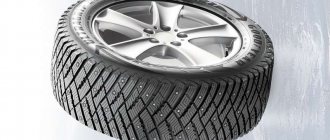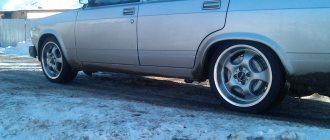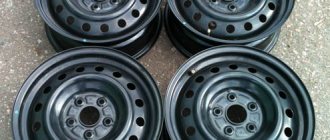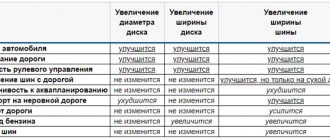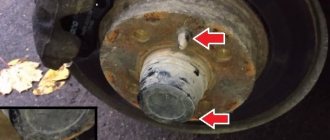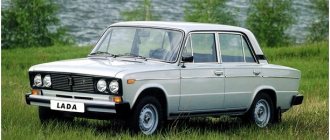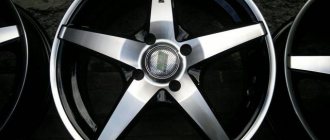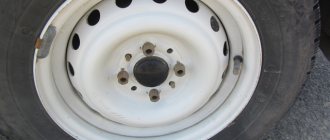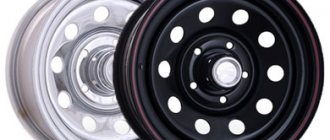PCD - what is this parameter?
The standard wheel marking looks like this: 7×17/5×108 D63.3 ET50. It includes four components. Let's decrypt it.
The first parameter consists of two numbers: 7×17, where 7 is the width of the disk landing flange, expressed in inches; 17 is the diameter of the annular part of the rim, also measured in inches. The latter must correspond to the tire diameter. The tire marking is usually indicated as 17R.
The second parameter is also two numbers 5x108, and they interest us most. 5 is the number of holes for mounting the disc on the hub. There can be 3, 4, 5 or even 6. There can be as many as 15 on trucks. 108 is the diameter of the circle along all centers of the mounting holes, expressed in millimeters. This is PCD, or Pitch Circle Diameter. This characteristic in tire fitting is also often called drilling or bolt pattern. The PCD must completely match the dimensions of the hub, otherwise installing the wheel on the car will be very problematic, if not completely impossible. Only eccentrics can save you, but you can only ride them temporarily.
Next comes the DIA parameter – D63.3, indicating the diameter of the central (hub) hole in millimeters. On light alloy wheels it is usually closed with a seal.
The ET50 marking is the wheel rim offset in millimeters, i.e. the distance between the mounting plane of the disk and the middle of its width. The offset can be positive, zero or negative. The smaller the offset, the larger the car's track, and the wheels protrude more beyond the car's body.
Expert advice
When purchasing rims, experts advise paying attention to the following details:
- If you buy a stamped disc, be very careful when selecting parameters. Even a deviation of 0.1 mm will be critical: steel wheels do not use adapter rings, so you will not be able to ride on such wheels.
- The diameter of the central hole on cast disks can be easily determined using a special plastic ring. With it you will find out the exact parameters without resorting to outside help.
- If you purchase original wheels for your car, then you will not need any adapter wheels. As a rule, such a product is manufactured exactly to the parameters of the hub hole of a car of a certain brand.
What happens if the PCD diameter is neglected?
All parameters are important for installation; the installer will center the disk to the hub, which will make tightening the bolts much easier. The more accurately the wheel aligns with the hub, the more fully it will reveal its useful properties of handling and braking.
But if the width, rim diameter and offset can be changed to one degree or another, then the drilling is fixed once and for all by the manufacturer, since the design of the hub is simply not intended for mounting a wheel rim of a different size. For example, your car has a bolt pattern on the hub of 5×114.3, i.e. five bolt holes and 114.3mm circle diameter. And you want to buy a rim with 5×111, i.e. five holes with a circle diameter of 111 mm. The first parameter completely matches, but the second is a failure. It seems that the difference is only three millimeters, but it is fundamental. It is unlikely that even a professional will be able to visually identify a wheel with incorrect drilling if he does not know the numbers.
Violation of the disk parameters will lead to the fact that it cannot be properly centered and tightened. As a result, only one nut will be fully tightened, and the rest will sit, at best, skewed. The consequence of this will be a dynamic imbalance - the wheel will begin to sway imperceptibly from side to side, wear out the suspension and steering mechanism, and provoke body vibration, which sooner or later will lead to breakdown or even an accident.
Before experimenting with diameters, check the manufacturer's recommendations. Otherwise, incorrectly selected parameters can cause deformation of the wheel rim, runout, or even the wheel will simply fall off.
Pros and cons of enlarging the center hole
What does the central hole affect, and will the technical parameters of the car change if it is enlarged? The positive aspects of a disk with a universal central diameter include:
- Availability – these discs can be found everywhere. As a rule, they are produced for a large number of brands and models, so choosing the one you need will not be difficult.
- Versatility - wheels with a large central hole fit many models.
- Price – since such a product is produced in large quantities, the price for it is slightly lower than for “exclusively” selected discs.
How to measure the PCD parameter on disks yourself?
On cast models, as a rule, all these indicators are indicated on the packaging or they are extruded on the surface. If there is none, then you can measure the PCD on the disk yourself.
This also makes sense because some manufacturers indicate parameters that are slightly larger than what they actually are. It is better to first check the diameter with the manufacturer, and then check the data yourself. As they say: trust, but verify.
There is nothing complicated in measuring the diameter of a PCD, but you shouldn’t approach this matter carelessly, because between 4x98 and 4x100 the difference only seems modest. Most often, diameter measurements are carried out using a caliper. Let's take a standard five-hole rim and take two measurements:
- From the inside edge of the mounting hole to the near edge of the center hole. For example, we get 20 mm.
- From the outer edge of the mounting hole to the far edge of the center hole. Here it turned out to be 92 mm.
You will get two values that need to be added together to get the PCD diameter we need. 92 mm + 20 mm = 112 mm. As a result, we got a PCD equal to 5x112.
If you don't have a caliper on hand, you can try measuring the wheel with a ruler. Here, the technology for measuring diameter is the same as in the previous case, but it is not always possible to obtain accurate data due to error. The main thing is to make sure that the ruler passes exactly through the middle of the main hole.
You can also try to get by with an ordinary stationery compass, which every schoolchild has. But this method is not particularly accurate, and should be used as a last resort. We place the needle in the core of the disk and draw a circle along the centers of the mounting holes. Then we fix the radius, apply the compass to the ruler twice and get the diameter.
You can often find another way: measure the distance between the centers of the two farthest holes for fasteners and multiply by the coefficient:
- For a rim with three holes, multiply by 1.155;
- Four disks - 1.414;
- Five – 1.701;
- Six – 2.0.
For wheels with three or five bolt holes, this measurement will not be accurate, but it can be easily corrected by simply comparing it with the standard sizes of new wheels. The easiest way to measure the diameter of a disk without a coefficient is if it has four or six holes for fasteners - we simply measure the distance from the extreme point of two opposite holes, and then measure the diameter of the hub hole and add up the results.
If you still have the car's operating instructions, then you don't have to look for a caliper or ruler, but just look at the section with technical specifications. Or find your wheel on the Internet.
Nowadays, many stores have data on PCD diameter and other parameters of cars, and the buyer does not need to worry about making a mistake. Our online store will help you choose a wheel based on the make of your car and other characteristics. All you need to do is enter your details and add your purchase to the cart. Our filter will offer all models that can be installed on a particular car. Note that the only parameter that remains unchanged in either case is PCD.
As a rule, these characteristics are standardized among different car manufacturers. For example, in modern Audi models the diameter of the PCD disc is always 5x112, BMW produces cars with a size of 5x120, Ford has a very small drill hole - 5x108, on domestic VAZs it is even smaller - 4x98. Take these parameters into account and there should be no problems with the selection of wheel rims.
If for some reason you need to install a wheel from another manufacturer, you need to do this with caution, and it is better to check with the manufacturer for information - perhaps wheels for different brands are in principle incompatible.
Additional markings of disks and decoding of their designations
The parameters listed above are fundamental when choosing a wheel for a car. However, on some of them you can find additional inscriptions and markings. For example:
- MAX LOAD . This abbreviation means what is the maximum permissible load allowed for a particular wheel rim. Typically the number is expressed in pounds (LB). To convert a value in pounds to a value in kilograms, simply divide by a factor of 2.2. For example, MAX LOAD = 2000 LB = 2000 / 2.2 = 908 kilograms. That is, disks, like tires, have a load index.
- MAX PSI 50 COLD . In this particular example, the inscription means that the maximum allowable air pressure in the tire mounted on the rim should not exceed 50 pounds per square inch (PSI). For reference, pressure equal to one kilogram-force is approximately 14 PSI. To convert the pressure value, use a calculator. That is, in this particular example, the maximum permissible tire pressure should not exceed 3.5 atmospheres in the metric coordinate system. And the inscription COLD means that the pressure must be measured in a cold tire (before the car starts moving, including not under the scorching sun).
- FORGET . This inscription means that a particular disc was made using the forging method (that is, forged).
- BEADLOCK . This means that the wheel is equipped with a so-called tire locking system. Currently, it is prohibited to use such disks for security reasons, so they are no longer commercially available.
- BEADLOCK SIMULATOR . Such an inscription indicates that the disk contains a simulator of the tire fixation system. In this case, such disks can be used everywhere. In practice, this means that these disks are no different from ordinary ones.
- SAE/ISO/TUV . These abbreviations refer to the standards and regulatory bodies to which the discs were manufactured. On domestic tires you can sometimes find GOST values or manufacturer specifications.
- Date of manufacture . The manufacturer indicates the corresponding production date in encrypted form. This is usually four digits. The first two of them mean the week in a row, starting from the beginning of the year, and the second two - the year of manufacture itself. For example, the designation 1217 indicates that the disc was manufactured in the 12th week of 2022.
- Country of manufacture . On some discs you can find the name of the country in which the product was manufactured. Sometimes manufacturers only leave their logo on the disc or simply write the name.
Markings on Japanese wheels
On some discs produced in Japan, you can find the so-called JWL marking . Translated from English, the abbreviation means Japanese alloy wheels. This marking is applied only to those discs that are sold in Japan. Other manufacturers may apply the appropriate abbreviation if desired. However, if it is on the disk, it means that the disk meets the requirements of the Ministry of Land, Infrastructure, Transport and Tourism of Japan. By the way, for trucks and buses the similar abbreviation will be slightly different - JWL-T.
There is another non-standard marking - VIA . It is applied to the disc only if the product has passed successful tests in the laboratory of the Japanese Transport Inspection. The abbreviation VIA is an officially registered trademark. Therefore, applying it to discs that have not passed the appropriate tests is punishable. Therefore, discs on which the indicated abbreviation is printed will initially be of very high quality and durable.
Humps
Another parameter that may or may not be present in the disc marking is the letter “H”. It denotes the shape and presence of humps. Hamp, translated into Russian, is a ledge. These protrusions are necessary to secure tubeless tires and hold air in the cylinder. There are several configurations of the annular protrusion:
- H – there is only one annular protrusion on the disk;
- H2 – there are two identical annular protrusions on the rim;
- FH – flat hump;
- CH – combined hump (Combi Hump);
- AH – Asymmetric Hump.
If instead of the marking “H” there is a liter “X”, then the disc is non-separable and without ring protrusions.
Take into account the rules for deciphering wheel rim parameters. Thus, you will be able to purchase disks of the required design. As a result, the car will meet factory specifications and delight the owner.
Results
Experienced motorists often say that you should never save on two parts of your car - wheels and brakes. What diameter of the central hole of the wheel rim needs to be chosen so that the car drives like clockwork? This parameter is not the main one when choosing a “new thing” for your car. But it is certainly worth considering when purchasing; do not take a size smaller than the diameter of the hub. But if you take a disk with a hole slightly larger than necessary, then nothing bad will happen. The main thing is to contact a trusted tire shop, which will install new wheels with all the additions necessary for your safety.
